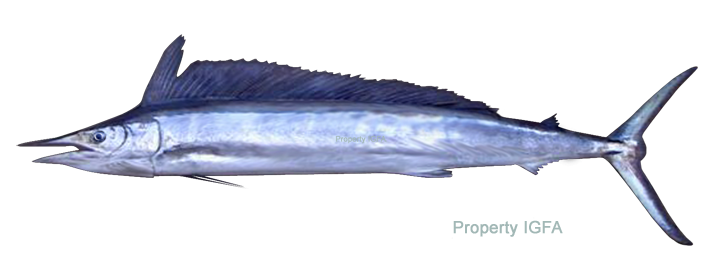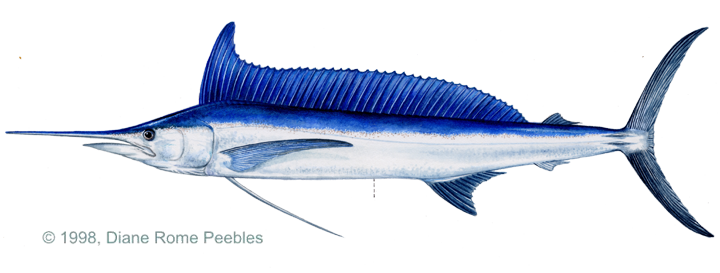Game Fish Identification Reference Guides
Spearfish, shortbill
(Tetrapturus angustirostris)
(Tetrapturus angustirostris)

Similar species: longbill spearfish, Tetrapturus pfluegeri (Robins & de Sylva, 1963); Mediterranean spearfish, Tetrapturus belone (Rafinesque, 1810); roundscale spearfish Tetrapturus georgi (Lowe, 1841); ISTIOPHORIDAE FAMILY;
The shortbill spearfish has a specific line class. Other spearfish inhabiting the Atlantic Ocean and Mediterranean are in a separate line class as Atlantic spearfish, Tetrapturus spp.
The spearfishes are cosmopolitan, but nowhere are they abundant. The longbill spearfish is known to occur in the northwest Atlantic from New Jersey to Venezuela, including the Gulf of Mexico. Japanese longliners have also recorded its occurrence in the north central Atlantic, in the south Atlantic, and off South Africa. The shortbill spearfish (T. angustirostris) is known in the Pacific and Indian Oceans. It is not reported to occur in the Mediterranean, but has been captured in the Atlantic Ocean west of the Cape of Good Hope, South Africa. The Mediterranean spearfish is known to occur only in the Mediterranean Sea.
Roundscale spearfish are found in both the eastern and western Atlantic. They bear an uncanny resemblance to white marlin, but can be distinguished by their longer branchiostegals and the position of the anus which is located four to six inches forward of the anal fin. This later characteristic separates the spearfishes from all other billfish.
The bill of the shortbill spearfish is barely longer than its lower jaw, whereas in the longbill spearfish it is about twice as long, but still quite short by billfish standards. The pectoral fins of the shortbill and Mediterranean spearfishes barely reach to the curve of the lateral line. In the longbill spearfish they extend beyond the curve. The longbill spearfish has more elements (45 to 53) in the first dorsal fin than any other Atlantic billfish. The shortbill spearfish of the Pacific has approximately the same count (47 50 elements), but the Mediterranean spearfish has fewer (39 46). The lateral line is single and arches above the pectoral fins. The dorsal fin is bright blue and has no spots. The vertical bars on the body are never as prominent as in other billfish and may show only slightly or not at all.
They are pelagic, off shore, deep water fishes. They feed at or near the surface, mainly on small and medium sized fishes and squids, including dolphin, sauries, flying fish, needlefish and pilot fish. They appear to be available all year in small numbers. Fishing methods are the same as for other billfish, but with lighter tackle. Most are taken incidentally. Spearfishes are fairly good eating, though the flesh is dark.
Available data indicate that the longbill spearfish matures by the age of two and rarely lives past three years of age. Maximum age may be four to five years.
The shortbill spearfish has a specific line class. Other spearfish inhabiting the Atlantic Ocean and Mediterranean are in a separate line class as Atlantic spearfish, Tetrapturus spp.
The spearfishes are cosmopolitan, but nowhere are they abundant. The longbill spearfish is known to occur in the northwest Atlantic from New Jersey to Venezuela, including the Gulf of Mexico. Japanese longliners have also recorded its occurrence in the north central Atlantic, in the south Atlantic, and off South Africa. The shortbill spearfish (T. angustirostris) is known in the Pacific and Indian Oceans. It is not reported to occur in the Mediterranean, but has been captured in the Atlantic Ocean west of the Cape of Good Hope, South Africa. The Mediterranean spearfish is known to occur only in the Mediterranean Sea.
Roundscale spearfish are found in both the eastern and western Atlantic. They bear an uncanny resemblance to white marlin, but can be distinguished by their longer branchiostegals and the position of the anus which is located four to six inches forward of the anal fin. This later characteristic separates the spearfishes from all other billfish.
The bill of the shortbill spearfish is barely longer than its lower jaw, whereas in the longbill spearfish it is about twice as long, but still quite short by billfish standards. The pectoral fins of the shortbill and Mediterranean spearfishes barely reach to the curve of the lateral line. In the longbill spearfish they extend beyond the curve. The longbill spearfish has more elements (45 to 53) in the first dorsal fin than any other Atlantic billfish. The shortbill spearfish of the Pacific has approximately the same count (47 50 elements), but the Mediterranean spearfish has fewer (39 46). The lateral line is single and arches above the pectoral fins. The dorsal fin is bright blue and has no spots. The vertical bars on the body are never as prominent as in other billfish and may show only slightly or not at all.
They are pelagic, off shore, deep water fishes. They feed at or near the surface, mainly on small and medium sized fishes and squids, including dolphin, sauries, flying fish, needlefish and pilot fish. They appear to be available all year in small numbers. Fishing methods are the same as for other billfish, but with lighter tackle. Most are taken incidentally. Spearfishes are fairly good eating, though the flesh is dark.
Available data indicate that the longbill spearfish matures by the age of two and rarely lives past three years of age. Maximum age may be four to five years.













